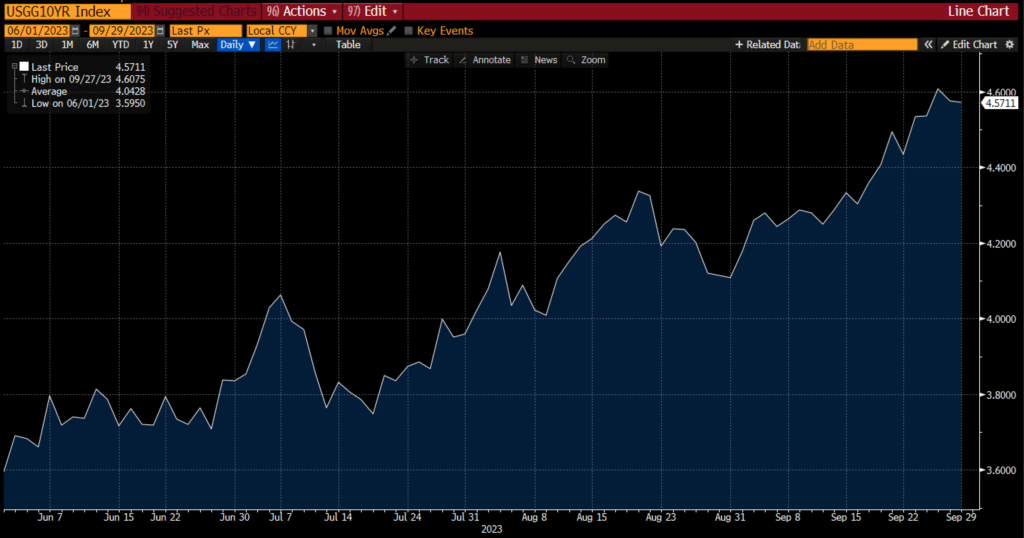Quarterly Newsletter for 2023’s 3rd Quarter

After three consecutive quarters of positive returns, stocks pulled back in the third quarter with the S&P 500 Index declining 3.3%. Other asset classes, such as small/mid-cap stocks and international equities posted slightly larger declines. Attributing the quarterly pullback to poor economic data or disappointing corporate earnings results would be difficult. Recent economic data points and earnings releases have generally been strong and better than expected. The weakness in risk assets was a result of the sharp and rapid spike in interest rates that occurred in the quarter.
Increase in 10-Year U.S. Treasury Bond Yields in the Third Quarter
With bond yields rising to the highest levels in more than 15 years, fixed income allocations provided no ballast to portfolio returns. Intermediate and long-maturity bond indices posted declines similar to equity markets, erasing positive year-to-date returns. However, on the positive side, the significantly higher bond yields currently being locked in when new bonds are purchased in portfolios should help buffer bond price volatility going forward.
We can attribute the spike in interest rates/bond yields to a wide range of issues and developments that warrant monitoring. An abbreviated list includes the following:
- Economic growth has remained solid. In fact, the Federal Reserve Bank of Atlanta estimates a third-quarter GDP growth rate of close to 5%.
- Oil prices increased by almost 30% in the quarter, which had an observable impact on headline inflation.
- While the Federal Reserve decided to leave interest rates unchanged at their September meeting, they stressed their “higher for longer” mantra, increased their economic growth forecast, and are now projecting fewer interest rate cuts in 2024 compared to their view in June.
- In early August, Fitch Ratings downgraded U.S. Treasuries from AAA to AA+ due to a growing debt burden and political dysfunction in Washington.
- The Treasury Department released borrowing estimates for the second half of the year, which were significantly higher than expectations. The Treasury plans to borrow a staggering $1 trillion in the third quarter and another $852 billion in the fourth quarter. Unsurprisingly, the massive increase in supply has translated into lower bond prices and higher bond yields.
In the near term, we expect the path of interest rates to dictate the direction of financial markets. It will be challenging for equity markets to advance without stabilization in the bond market. We do see several developments that have the potential to lower interest rates. Economic momentum is likely to slow after a surprisingly strong third quarter as tighter monetary and credit conditions weigh on economic growth. Consumers have nearly depleted excess savings that have supported elevated spending levels. The timing of this development corresponds with a tick-up in delinquencies on auto loans and credit card debt. Outside of the spike in oil prices, there have been some positive developments on the inflation front. Wage growth has cooled and the most recent core inflation reading came in at 2.2% using a three-month annualized rate. While these data points may not align with expectations for a rip-roaring economy, that’s not the outcome investors want to see. We’re in a “bad news is good news” environment where investors want to see evidence of a cooling economy that brings down inflation and interest rates.
While several of the factors contributing to the recent spike in interest rates could reverse course, we acknowledge that the supply-demand picture for bonds is not encouraging at present. U.S. debt levels stand at $33 trillion, and Washington is running large budget deficits in a period of full employment. With no signs of fiscal restraint in D.C. and the Federal Reserve reversing course after a long stretch of supporting demand for government bonds through their Quantitative Easing programs, these supply-demand dynamics aren’t likely to improve any time soon. Policymakers need to come to terms with the fact that borrowing money is no longer free, and as such, the basic rules of economics apply to them as well. When supply overwhelms demand, the result is lower prices or, in this case, higher borrowing costs.
Fort Pitt Capital Group (FPCG) is an investment advisor registered with the United States Securities and Exchange Commission (“SEC”). For a detailed discussion of FPCG and its services and fees, see the Form ADV Part 1 and 2A on file with the SEC at www.adviserinfo.sec.gov. Registration with the SEC does not imply any level of skill or training. You may also visit our website at www.fortpittcapital.com.
Any opinions expressed are opinions held at the time of publishing and are subject to change. It does not constitute an offer, solicitation, or recommendation to purchase any security. The information herein was obtained from various sources; we do not guarantee its accuracy or completeness. Past performance does not guarantee future results. The performance shown is for illustrative purposes only and the intent is to show the performance of certain segments of the markets. This information is not reflective of the performance of any FPCG client, or the impact of security selection on actual client portfolios. Actual results and developments may be substantially different from the expectations described in the forward-looking statements included herein.
The S&P 500 is a broad-based index of 500 stocks, which is widely recognized as representative of the equity market in general. The Bloomberg U.S. Aggregate Bond Index is a broad-based index of intermediate term investment grade bonds traded in the U.S. These indices are unmanaged and may represent a more diversified list of securities than those recommended by FPCG. In addition, FPCG may invest in securities outside of those represented in the indices. The performance of an index assumes no taxes, transaction costs, management fees or other expenses. Additional information on any index is available upon request.
Fort Pitt and its representatives may, from time to time, make forward-looking statements about developments, results, conditions or other events that the firm anticipates will occur in the future. Forward-looking statements are based on the firm’s views as of the date of this publication. Actual results may differ materially from those projected.
© Copyright 2023 by Fort Pitt Capital Group LLC. All rights reserved.
Fort Pitt votes proxies for client accounts as requested by our clients. A copy of Fort Pitt’s proxy voting policies, as well as information regarding how a particular issue was voted, is available by contacting the firm at 412-921-1822.
.



